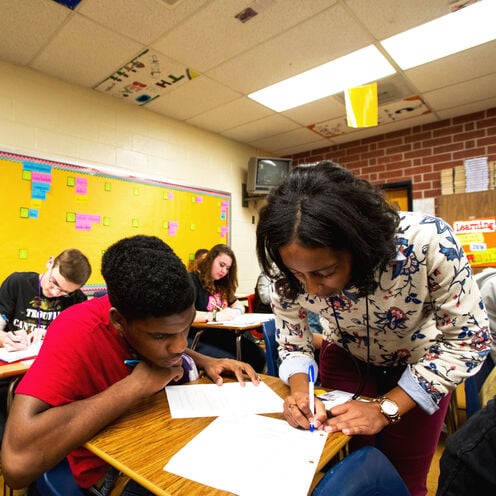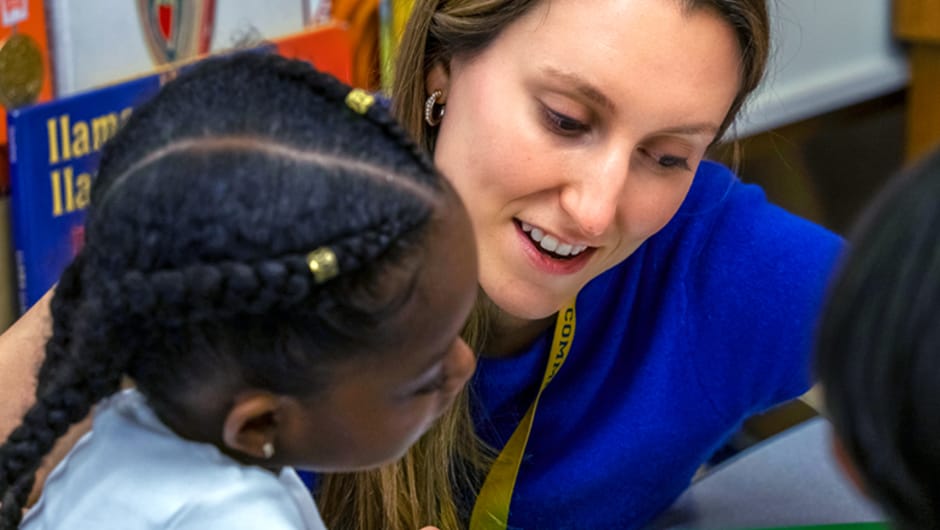
The Latest NAEP Data Is Devastating: What Do We Do Now?
Teach For America CEO Elisa Villanueva Beard calls for our country to seize this moment to reinvent education given historic declines in NAEP scores in the wake of the pandemic.
The immense challenges facing our education system are no secret.
Two rounds of new data from the National Assessment of Educational Progress, often called The Nation’s Report Card, confirm that we cannot continue on the current path. NAEP’s long-term trend assessment results, released last month, show two decades of progress for American students evaporating amid the disrupted learning time of the pandemic. NAEP data on math and reading proficiency for fourth and eighth graders, released this week, provide the most comprehensive evidence to date of just how profound the impact of the pandemic has been.
Between 2019 and 2022, reading and math scores saw historic declines in most states, with math scores being especially troubling. The national average score declines in math were the largest ever recorded for fourth and eighth graders.
Nationally, since 2019, the average math score dropped five points for fourth graders while scores for eighth graders fell eight points. Both groups’ math scores fell to levels not seen in roughly two decades. Average reading scores declined significantly, too, falling three points since 2019. That’s the same level seen in 1992, the first year of the reading exam. If not for reading scores staying steady in most urban districts measured—with Los Angeles seeing an actual increase, in eighth grade reading scores—reading outcomes would be unrelentingly grim.
“These results should drive a national effort to create a fundamentally different educational experience for our children.”
Every state saw declines on at least one exam, and most states on multiple exams. And even though progress has been made over time—with average math scores for fourth and eighth graders still significantly higher than in 1990, the year the math assessment was first administered—cracks in the system that existed pre-Covid have become gaping holes. Black and Hispanic fourth graders and students who were already struggling before the pandemic lost the most ground.
These results should drive a national effort to create a fundamentally different educational experience for our children. This is not a challenge for schools alone to solve; it’s a challenge for communities to come together and prioritize future generations. We each have a role to play in ensuring a rich educational experience for students inside the school and leveraging the incredible talent that exists outside of schools. In our path forward, we must ground everything we do in students’ aspirations, interests, and wellbeing and ensure we are taking an equitable approach. We must also commit to evidence-based solutions, given how much we have learned over decades about what works to accelerate impact.
Visiting classrooms and speaking with educators in rural and urban America, I see three big lessons from the last three years that should serve as a springboard to reinventing our education system:
Lesson 1
When schools shut down and classrooms migrated to computers and kitchen tables, young people struggled to drive their own learning and manage their time. A major reason: They weren’t prepared to do this because our country’s traditional schooling model emphasizes compliance, completion, and seat time.
What this means: We must develop models that center the learner, so students are active agents in their learning and build on their own experience, ideas, and knowledge.
Get more articles like this delivered to your inbox.
The monthly ‘One Day Today’ newsletter features our top stories, delivered straight to your in-box.
Content is loading...
Lesson 2
Within the same home, families could see that one child thrived virtually while another might be floundering without the social aspect of classroom learning. Student engagement, motivation, and mastery of content varied dramatically in pace and progress.
In the pandemic’s wake, the rates of chronic absenteeism—as high as 41 percent in New York and 30 percent in Los Angeles—showed that schools are having a hard time motivating or engaging students. Even before the pandemic, in 2019, a national survey found that 1 in 3 high school students are bored most or all of the time in school.
What this means: When it comes to learning, one size does not fit all. There are many reasons that students disengage from school, but it’s clear that making school more applicable to their lives and interests is urgent. For example, there are opportunities to reconsider the traditional high school model to encompass internships, apprenticeships, and partnerships that break down the walls between school and community and recognize all the places where learning happens.
In addition to increasing engagement, we must be setting up learning experiences that develop the skills needed for the 21st century and jobs that may not even exist yet. We must customize learning for each student's strengths, needs, skills, and interests. Students want educational experiences that are relevant to their lives and their aspirations for the future.
“We must redouble our efforts and deeply invest in the success of our students and teachers.”
Lesson 3
The trauma and loss of the last three years have deeply affected this generation of students. It’s estimated that more than 1 in 360 children lost a parent or caregiver in the pandemic. The American Psychological Association declared earlier this year that children’s mental health is in crisis.
What this means: Mental health must be a priority. Research shows us that mental wellbeing and safety are conditions of learning: When kids are out of a fight-or-flight state and are supported as people first in conditions that foster a sense of belonging, safety, and overall care, their minds open up to learning. Putting academics aside for a moment, young people deserve to be healthy, alive, and free from the anxiety and depression that is crushing so many of them right now.
As we work to ensure kids can thrive in and shape our world, we cannot lose focus on rigorous academics—that has always been and will continue to be critical.
Edgecombe County Public Schools in North Carolina is one example of what’s possible. They began a few years before the pandemic rethinking what school can and should be for students and educators. Today, students are driving their learning experiences. They are key inputs in curriculum design; they have blocks of time to work on issues and passions they care about.
Interested in Joining Teach For America?
The results? Kids have choice. They feel powerful. They feel loved and have a sense of belonging. And Edgecombe is seeing promising results: Prior to the first two pilots, North Edgecombe High School and Phillips Middle School were labeled as “F schools”—among the lowest-performing in the district. In the first three years of the schools, they outpaced expected growth metrics.
I believe our country has what it takes to tackle the immense challenges underscored by the latest NAEP results. This is not a moment to lose hope. We must redouble our efforts and deeply invest in the success of our students and teachers. We must commit to our students for the long term, doing all we can to accelerate their learning, support their physical and mental health, and enable them to lead and thrive now and in the future.
As a country, we have proved we can do hard things when we activate our innovative spirit, work collectively, and set a big vision for what is possible. This is our moment—let's seize it.
Sign up to receive articles like this in your inbox!
Thanks for signing up!
Content is loading...






